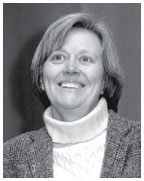
Shirley M. Tilghman |
A Campus “Town Meeting”
Over the last few years I have enjoyed the many opportunities I have had to talk with alumni about the University and to respond to their questions and receive their comments and constructive criticisms. One of my favorite venues has been the “Conversation with the President” on Saturday morning of Reunions weekend in Alexander Hall, where a sea of orange-and-black-outfitted loyalists ask questions about everything from admissions to international relations to alcohol consumption. I have also hosted large receptions with alumni in dozens of cities throughout the United States, Canada, Greece, and England, and I am looking forward to meeting with alumni in France this summer and in Asia next fall.
Earlier this spring several students pointed out that while I meet regularly with students in small groups, there is no event where the entire campus can interact with me. They proposed that I conduct a campus “town meeting,” and as I thought this was an excellent idea, I set aside most of the March meeting of the Council of the Princeton University Community (CPUC) for this purpose. The 34- year-old CPUC meets during most months of the academic year and its members include undergraduates, graduate students, faculty, staff, and alumni. In outlining what I consider to be some of Princeton’s current priorities, I mentioned:
• Planning for the expansion of our undergraduate student body from roughly 4,600 to 5,100, through the construction of Whitman College and the creation of a four-year college system that will allow interested juniors and seniors to continue to live in the residential colleges for all four years. This system will also provide continuing connections to the colleges for juniors and seniors who join the eating clubs or elect to eat independently, and it will provide living quarters for some 60 graduate students. I was able to remind this generation of students that the trustees decided to increase the size of the student body both because of the extraordinary quality of our applicant pool and because the size of the faculty has grown significantly over the past 30 years (reflecting the expansion of knowledge and the introduction of new fields of study) with no appreciable increase in the number of undergraduates. At the same time, the trustees have been insistent that we plan for this increase very carefully so that we fully preserve the distinctive features of a Princeton education, including opportunities for our students to work in close collaboration with members of the faculty.
• Planning for future growth of the University in a way that recognizes that one of our greatest treasures is the beauty of the campus. As we think about where we might grow in the future, we want to remain a “walkable” campus, we want to build in environmentally sensitive ways and we want to sustain the “neighborhoods” that have developed on campus over time so that related academic departments are close enough to each other to encourage interdisciplinary collaboration and so that we sustain our commitment to student residential and extracurricular life. One implication of these principles is that while we are likely to use our lands on the other side of Lake Carnegie in the future for faculty, staff, and graduate student housing and for playing fields and open space, we would not intend to use them for classroom buildings or undergraduate dormitories. We also care deeply about the preservation of green space on campus, and I pointed out that while it may be counterintuitive, the construction of Whitman College on the site of the tennis courts will actually create additional green space in the form of three gracious courtyards that will be framed by the college’s buildings. I also indicated that Princeton should continue to set high standards for building on campus, and commission works by the world’s most distinguished architects.
• Planning to strengthen our academic program in selected areas, and especially over the next few years in engineering and the creative arts. I have written recently in this page about the results of a yearlong strategic planning process in the School of Engineering and Applied Science. Dean Klawe has laid out a very exciting vision of the distinctive leadership role that Princeton is uniquely able to play in setting new standards for engineering education and research with the intent of educating leaders, instilling engineering with an interdisciplinary perspective, and placing engineering in its full societal context. Meanwhile, I have been spending much of my time this year thinking about ways that we can build on the enormous progress that Princeton has made in recent years in the creative and performing arts so that even more of our students can integrate the arts into their academic programs.
When it came time for questions, the range was just as broad as it is
when I meet with alumni. Altogether I was asked 18 questions, on topics
that ranged from the diversity of our faculty, student body, and academic
programs to the likely impact of the four-year colleges; from housing
for graduate students to undergraduate admission policy; from policies
designed to encourage technology transfer to initiatives that might encourage
civic engagement and government service. The questions reflected the broad
range of issues that I am privileged to think about every day. At the
end there seemed to be general agreement that we ought to make this an
annual event in the future. I’m already looking forward to the next
one.![]()

